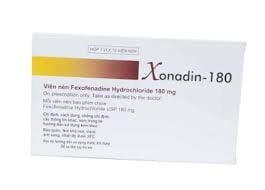This is an automatically translated article.
Flamoset belongs to the group of anti-allergic drugs, with the main ingredient being Levocetirizine dihydrochloride, commonly used to treat conditions such as allergic rhinitis, sneezing symptoms, runny nose,... Learn some information about Uses, dosages and notes when using Flamoset will help patients use the drug safely and effectively.
1. Uses of the drug Flameset
Flamoset medicine has the main ingredient Levocetirizine, which is a 2nd generation histamine H1 receptor antagonist, used to treat various allergy symptoms such as sneezing, runny nose,... long-acting, can be used as a single daily dose for symptomatic treatment. Regarding the mechanism of action, Levocetirizine is the active (R) optical isomer of cetirizine - an antihistamine, the effect of which is mainly mediated by selective inhibition of peripheral H1 receptors. Research shows that Levocetirizine has 2 times more affinity for H1 receptors than Cetirizine. In terms of pharmacokinetics, Levocetirizine is dose-linear, time-independent, and does not undergo isomeric translocation during absorption and elimination. The drug is rapidly and strongly absorbed after oral administration, reaches peak plasma concentrations after 0.9 hours of oral administration, is metabolized and finally eliminated mainly in the urine (mainly renal tubular secretion). The drug Flamoset is usually indicated in the following cases:
Seasonal allergic rhinitis (including ocular symptoms); Chronic allergic rhinitis; Chronic eczema ; Symptoms of runny nose, itchy nose, watery eyes, red eyes; Uncomplicated skin manifestations of chronic idiopathic urticaria in adults and children over 6 years of age. Contraindications of the drug Flamoset include:
Patients with hypersensitivity to Levocetirizine or any component of Flamoset; Patients with end-stage chronic kidney disease (CrCl < 10ml/min), patients on hemodialysis; Children aged 6 months to 11 years with impaired kidney function.
2. Dosage of the drug Flameset
Depending on the subjects and treatment goals, the dose of Flamoset will be different, specifically as follows:
Adults: 5mg/day in the evening; Children 6-11 years old: Recommended dose 2.5mg/day in the evening; Patients with mild renal impairment (CrCl 50-80ml/min): 2.5mg x 1 time/day; Patients with moderate renal impairment (CrCl 30-50ml/min) use 2.5mg every other day; Patients with severe renal impairment (CrCl from 10-30ml/min) dose 2.5mg x 2 times/week (used once every 3-4 days); Patients with end-stage renal failure (CrCl < 10ml/min) and on hemodialysis should not take Levocetirizine; No dose adjustment of Flamoset is required in patients with hepatic impairment. Overdose of Flamoset can cause drowsiness in adults, children may be agitated, restless and then sleepy. There is currently no specific antidote to Levocetirizine, if an overdose occurs, symptomatic or supportive treatment is recommended mainly. Gastric lavage should be considered if the patient has recently taken the drug for a short time. Levocetirizine is not effectively removed from the circulation by dialysis.
3. Flamoset . side effects
In some patients when using Flamoset, side effects may occur such as:
Dry mouth, taste disturbances; Headache, fatigue, somnolence, weakness; Sore throat ; Stomachache; Hallucinations, depression, insomnia; Dizziness, fainting; Difficulty urinating, urinary retention, edema; Rare: Weight gain, appetite, abnormal liver function, palpitations, palpitations.
4. Be careful when using Flameset
Some general notes when using Flamoset include:
Caution when using Flamoset in patients with galactose intolerance, Lapp lactase deficiency, alcohol abusers; Avoid using Flamoset for pregnant and lactating women or while driving or operating machinery; Flamoset should be used with caution in patients with predisposing factors for urinary retention (spinal cord injury, prostatic hyperplasia) because levocetirizine may increase the risk of urinary retention; Flamoset should be used with caution in patients at risk of convulsions because it may cause more severe seizures; Itching may occur even after levocetirizine is stopped.
5. Drug interactions with Flameset
The risk of side effects when taking Flamoset may be increased when combined with 1,2- Benzodiazepine, Acetazolamide , Acetophenazine; Abacavir, Aceclofenac, Acemetamine, acetylsalicylic acid may decrease the rate of excretion of Levocetirizine, resulting in increased serum concentrations; Levocetirizine may increase the CNS depressant activity of Aclidinium; Increased risk or severity of QT interval prolongation when Acrivastine is combined with Levocetirizine; In susceptible patients, concomitant use of levocetirizine with alcohol or other CNS depressants may affect the central nervous system. Above is the entire information about the drug Flamoset, patients need to carefully read the instructions for use, consult a doctor / pharmacist before use. Note, Flamoset is a prescription drug, patients need to use the drug as prescribed by the doctor, absolutely do not self-treat at home.













